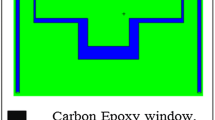Abstract
Low activities of radionuclides in environmental and occupational samples demand for the lower detection limits of the measuring system, which can be achieved by minimizing the source-to-detector distance. Analytical technique to calculate full-energy peak efficiency and total efficiency, self-absorption of sources and a coincidence factor of the NaI cubic scintillation detector with rectangular cavity for rectangular source have been derived. The photon path length of the volumetric sources calculated and determined source self-absorption. The photon attention by rectangular sources and detector cap materials is also calculated. In the experiments gamma aqueous source containing Eu-152 radionuclide covering range from 121 to 1408 keV was used. By comparison analytical method for calculating the full energy peak efficiency and the corrected experimental efficiency values are in good a agreement.





Similar content being viewed by others
Change history
20 February 2021
A Correction to this paper has been published: https://doi.org/10.1007/s10967-021-07631-0
References
Badawi MS, Noureddine S et al (2020) Characterization of the efficiency of a cubic NaI detector with rectangular cavity for axially positioned sources. J Insturm 15:P02013
Abbas MI, Badawi MS et al (2020) Efficiency of a cubic NaI(Tl) detector with rectangular cavity using standard radioactive point sources placed at non-axial position. Appl Radiat Isot 163:109139
Lee M, Park TS, Woo JK (2008) Coincidence summing effects in gamma-ray spectrometry using a Marinelli. Appl Radiat Isot 66:799–803
Abbas MI (2001) HPGe detector photopeak efficiency calculation including self-absorption and coincidence corrections for Marinelli beaker sources using compact analytical expressions. Appl Radiat Isot 54:761–768
Abbas MI (2007) Direct mathematical method for calculating full-energy peak efficiency and coincidence corrections of HPGe detectors for extended sources. Nuclear Instrum Methods Phys Res Sect B Beam Interact Mater Atoms 256:554–557
Tomarchio E, Rizzo S (2011) Coincidence-summing correction equations in gamma-ray spectrometry with p-type HPGedetectors. Radiat Phys Chem 80:318–323
El-Khatib AM, Badawi MS et al (2017) Full-Energy peak efficiency of an NaI (Tl) detector with coincidence summing correction showing the effect of the source-to-detector distance. Chin J Phys 55:478–489
Jäderström H, Mueller W et al (2017) True coincidence summing correction and mathematical efficiency modeling of a well detector. Nuclear Instrum Methods Phys Res Sect A Accel Spectrom Detect Assoc Equip 784:264–268
Debertin K, Ren J (1989) Measurement of activity of radioactive samples in Marinelli beakers. Nuclear Instrum Methods Phys Res Sect A 278:541–549
Elsafi M, Gouda MM et al (2017) Using mathematical procedure to compute the attenuation coefficient in spectrometry field. J Radiol Oncol 1:022–033
Santos TO, Rocha Z, et al (2015) Determination of the self-attenuation correction factor for environmental samples in gamma spectrometry. In: International nuclear AIC conference—INAC (2015), São Paulo, SP, Brazil, pp 4–9
Moens L, Doner J et al (1981) Calculation of the absolute peak efficiency of gamma-ray detectors for different counting geometries. Nuclear Instrum Methods Phys Res 187:451
Debertin K, Schotzig U (1979) Coincedence summing correction in Ge(Li) spectrometry at low source-to-detector distances. Nuclear Instrum Methods 158:471–477
Yoon ET, Kang MY (2020) Coincidence summing correction for a voluminous 152Eu source. Nucl Eng Technol 52:1266e1270
Badawi MS, Jovanovic SI et al (2017) Calibration of 4π NaI(Tl) detectors with coincidence summing correction using new numerical procedure and ANGLE4 software. AIP Adv 7(19):0350051
Author information
Authors and Affiliations
Corresponding author
Additional information
Publisher's Note
Springer Nature remains neutral with regard to jurisdictional claims in published maps and institutional affiliations.
Rights and permissions
About this article
Cite this article
Abbas, M.I., Elsafi, M., Gouda, M.M. et al. NaI cubic detector full-energy peak efficiency, including coincidence and self-absorption corrections for rectangular sources using analytical method. J Radioanal Nucl Chem 327, 251–258 (2021). https://doi.org/10.1007/s10967-020-07508-8
Received:
Accepted:
Published:
Issue Date:
DOI: https://doi.org/10.1007/s10967-020-07508-8



